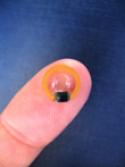 Sensors can monitor production processes, unmask tiny cracks in aircraft hulls, and determine the amount of laundry in a washing machine. In future, they will also be used in the human body and raise the alarm in the event of high pressure in the eye, bladder or brain.
If the pressure in the eye is too high, nerve fibers die, resulting in visual field loss or blindness. Since increased intraocular pressure, also known as glaucoma, is not usually painful, the condition is often diagnosed too late. Moreover, such patients often tend to develop cataracts when they get older – the lenses of their eyes become opaque. In such cases, surgeons remove the natural lens and replace it with an artificial one. To avoid further loss of nerve fibers, the intraocular pressure is then regulated as accurately as possible with the help of medication. Unfortunately, the pressure continues to vary despite medication, obligating the patient to have it constantly monitored by physicians and the medication dosage adjusted accordingly.
In future, a sensor developed by researchers at the Fraunhofer Institute for Microelectric Circuits and Systems IMS in Duisburg will obviate the need for constant visits to the physician by such patients. “We integrate the 2.5 by 2.6 millimeter sensor in the artificial lens,” says Thomas van den Boom, group manager for biohybrid systems at the IMS. “This doesn’t impair the patient’s vision.” The top and bottom of the sensor are formed by electrodes; the top electrode is flexible, in contrast to its rigid counterpart on the bottom of the sensor. When the intraocular pressure increases, the top electrode is pushed in, reducing the distance between the top and bottom of the sensor and thus increasing the capacitance. Using a tiny antenna, the implant then sends the pressure data to a reader that is fitted into the frame of a pair of spectacles. The patient can view the results on an auxiliary device and determine whether the pressure has reached a critical level. An antenna in the spectacle frame supplies the sensor with the required energy via an electromagnetic field. “The power consumption of the sensor must be kept to an absolute minimum,” explains van den Boom. “All unused components are put in a kind of standby mode and only activated when needed.”
The permanent eye implant is currently undergoing clinical trials and could come into general use in two to three years’ time. But the sensor is not only suitable for use in the eye: When implanted in blood vessels in the thigh or the upper arm it can also help patients with chronic hypertension. “Conventional devices for measuring blood pressure at home are not suitable for determining the correct medication dosage,” says van den Boom. The sensor is also expected to benefit patients suffering from increased intracranial pressure or those with incontinence problems.
http://www.fraunhofer.de/fhg/EN/press/
Разработан имплантируемый в глаз датчик давления
Миниатюрный датчик давления, разработанный немецкими учеными, найдет множество применений в промышленности и медицине.
Датчик имеет размеры всего 2,5 х 2,6 мм, при этом у него есть встроенная антенна для передачи данных наряду с возможностью проводного подключения. Одно из наиболее перспективных применений нового датчика - измерение внутриглазного давления, считает руководитель группы биогибридных систем в институте микроэлектронных схем и систем им. Фраунгофера (Дуйсбург, ФРГ) Томас ван ден Боом (Thomas van den Boom).
При слишком высоком внутриглазном давлении происходит атрофия зрительного нерва, что в конечном итоге приводит к слепоте, или, по крайней мере, частичной потере зрения. Повышение внутриглазного давления является проявлением глаукомы - распространенного заболевания, которое к 70 годам наблюдается у каждого из 50 европейцев (у афроафриканцев, например, этот показатель еще выше - 1 случай на 8 человек). Часто глаукому обнаруживают слишком поздно, и ранняя диагностика необходима для начала медикаментозного лечения болезни. Вовремя начатое лечение способно приостановить прогрессирование заболевания.
Датчик давления емкостного типа состоит из двух электродов, при этом верхний электрод гибкий, а нижний жесткий. При повышении внутриглазного давления расстояние между электродами сокращается, емкость изменяется, и электрический сигнал передается через миниатюрную встроенную антенну на внешнее устройство, которое выдает цифровые данные.
Приемное устройство может быть встроено в очки, чтобы уровень сигнала поддерживался на минимуме, при этом датчику не надо иметь собственного источника питания - он получает его от антенны внешнего устройства. Разработчики считают, что лучшее место для установки датчика давления - это искусственный хрусталик, который устанавливают взамен помутневшего естественного при развитии катаракты (заболевания, развиваюющегося часто одновременно с глаукомой).
Установка датчика давления в глазу пациента позволит осуществлять постоянный мониторинг давления и не обращаться слишком часто к врачу. Есть и другие возможные применения нового датчика - им можно измерять и артериальное, и внутричерепное давление. В промышленности или в авиации разработчики также видят разнообразные применения. По их мнению, медицинские датчики давления будут доступны пациентам уже через 2-3 года, после завершения клинических испытаний, сообщает
http://rnd.cnews.ru/tech/news/top/ |